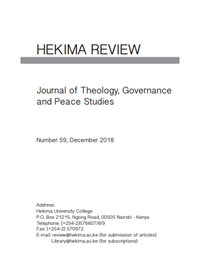Hekima Review No. 59 (Dec 2018)

Ten years ago, I had an immersion experience at the Ossiomo Leper Settlement in the South-southern part of Nigeria. For many of the inmates that I met, leprosy represented a tragic turning point in their lives. Each one told me stories about what life used to be before leprosy, and how all that changed like the snap of a finger. One of the inmates, a jovial woman would often reminisce about the beauty of her younger days, how no man could pass her by without turning, at least for a second look. “Where is such a man?” she would ask. Another inmate, a man, would tell me stories of how he had to leave everything he had worked for – his business, his properties, and his family – to begin life in this “no man’s land.” Their stories more often than not, climaxed with a decipherable pattern: how the infections hit them and things fell apart; how they were dropped at Ossiomo; how they were told that it would be just for a while and everything would soon be fine; how after the initial treatments, regular visits became occasional, then rare and eventually no more. Leprosy had made them citizens of nowhere.

